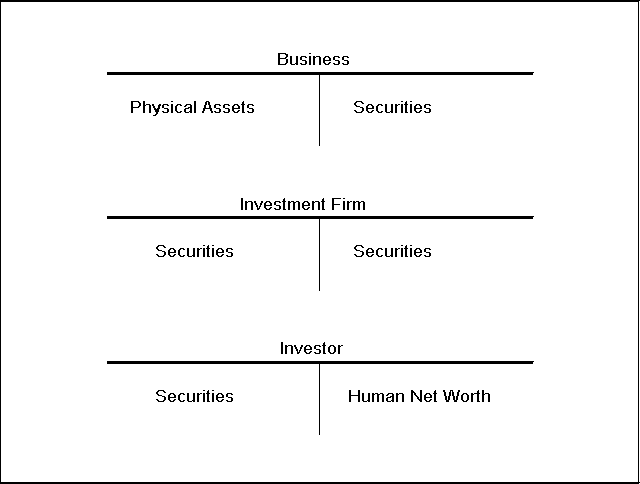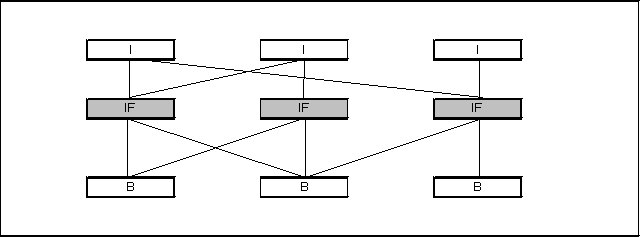
This work has some attributes of an investments text, but it is by no means a traditional one in either form or substance. The difference in the former is obvious. The difference in the latter is reflected in the title, which is, at this writing, unique. All three components of the title are relevant. The focus is on techniques of analysis that can lead to sensible top-level (macro-) investment decisions.
It is helpful to personalize some of the roles that will be of concern throughout this work. An Investor must ultimately select positions in various types of investment vehicles. In doing so, he or she can be assisted by an Analyst. Importantly, many of the investment vehicles used by investors are themselves packages of more fundamental positions -- packages provided by Investment Firms.
In practice of course, these three roles are rarely divided neatly among individuals and organizations. Some Investors provide at least part of the analysis required for appropriate decisions. Many investment decisions are made by intermediaries, such as pension funds, endowment funds and the like, charged with acting in the interests of those who will ultimately be the beneficiaries of the investments undertaken. The staffs of such organizations often provide much of the analysis needed for appropriate decisions. Some Investment Firms provide analytic services for investors. And so on. Nonetheless, it is useful to consider as distinct the functions of Investor, Analyst, and Investment Firm.
In essence, we concentrate on a multi-level approach to investing, with the Investor at the top level, assisted by the Analyst, a set of Investment Firms at a second level, and the securities of corporations at yet lower levels, as portrayed in the figure below.

Such a multi-level approach to investing is found both among individual and institutional investors. Individuals utilize shares of publicly-available investment funds (such as those called mutual funds in the United States, unit trusts in the United Kingdom, investment companies in Japan, etc.) which in turn hold securities of individual corporations. Large institutional investors such as pension funds use commingled funds or separately managed accounts (provided by banks, investment management firms, insurance companies and the like) which serve much the same purpose. Both can also make use of many types of derivative securities (provided by banks, exchanges, investment banking firms, etc.), the values of which reflect the performance of major sectors of various capital markets.
Macro-Investment Analyses are performed for individual investors by financial advisors, who either charge explicitly for such services ("for-fee Advisors") or are compensated implicitly via commissions received from Investment Firms for the sale of the latters' products. Investment brokers often serve the same function, either for a fee based on the assets managed (using so-called "wrap accounts") or for commissions based on the investments undertaken. Similar services are provided by insurance agents, private bankers, and others.
Macro Investment Analyses are performed for institutional investors by investment consulting firms. Those who work primarily with pension funds are often called pension consultants. Most such firms charge fees that are independent of the particular investments undertaken.
Not surprisingly, many of the techniques described in this work were initially developed by consulting firms for institutional investors with sufficiently large investments to justify the costs associated with sophisticated analytic methods and extensive data collection and analysis. However, the accumulation of substantial databases, advances in knowledge and decreases in computational and communications costs are making such procedures accessible economically to a much larger set of investors.
At this writing, there is a world-wide trend to give individuals more control over the investment of funds designed to cover retirement expenses. This makes it imperative that ways be found to provide the advice that will make it possible for such investment decisions to be taken rationally. One way or another, the skills of the Analyst must be applied widely.
Traditionally, investments texts have been directed to investors who plan to build portfolios of the securities of traditional corporations. However, in the real world such investors are becoming fewer and fewer. Increasingly, the construction of portfolios from corporate securities is an activity undertaken by Investment Firms whose goal is to provide components that may usefully be employed by Investors. The ultimate investor then focuses on finding an appropriate combination of such components, not on building an overall portfolio security by security.
This work is designed to provide the analytic skills needed to aid such Investors. It is thus explicitly directed to the Analyst. However, knowledge of its contents should help Investors utilize and evaluate the services offered by Analysts. In addition, Investment Firms familiar with its contents should be able to design products that will better meet the needs of Investors.
For emphasis, we will often capitalize Investor, Analyst and Investment Firm when used in the senses described above. This follows the legal tradition of using such notation to refer to previously "defined terms".
It is useful to contrast the multi-level approach to investments emphasized in this work with some alternatives. We present them roughly in the order in which they were introduced historically.
In simple societies, there is little distinction between savings and investment. One saves by reducing present consumption. One invests in the hope of increasing future consumption. Thus the woodsman who spares a tree for another year reduces consumption in the present (a long warm night by the fire) in the hope of increasing it in the future (warmer and longer nights by the fire next year). The tree is a productive investment -- barring floods, lightning strikes, etc., there will be more wood next year than there is this year.
In most societies, intermediary steps connect individuals' savings with productive investments. Such investments are usually undertaken by firms, using resources generated by the savings of individuals. In many cases governmental agencies perform roles similar to those of business firms.
In our terminology, the individual who saves (defers consumption) is an Investor. To avoid confusion with Investment Firms, we will use the term Business to refer to a firm or governmental agency engaged in productive investment.
Certainly the simplest (and no doubt earliest) form of investment is that in which each business is funded by one investor (or perhaps one family of investors). The figure below illustrates this, with I representing an Investor and B a Business.

Note that our woodsman conforms to this structure, although the Business (tree) is not separately identified as such .
While this simple form of investment provides the maximum possible incentive for the Investor to insure that the Business is run efficiently, it "puts all the Investor's eggs In one basket." It did not take long for Investors to realize that that some sort of risk-sharing could benefit all concerned. For example, at one time, each ship sent from London to bring back spices from the Orient was financed by one merchant. If the ship happened to sink, the investor lost everything. But if several merchants pooled their resources, with each taking partial interests in several ships, risk could be greatly reduced, with no diminution in overall expected return. Such pooling could be accomplished in a number of ways. One of the simpler procedures involved the issuance of "ownership shares" (not surprisingly), with each investor holding a diversified portfolio of shares in several ships. Considering each such ship a business, this is diagrammed below.

Note that such an arrangement has its drawbacks. Greater separation of ownership and control is required, and monitoring of the managers of the Businesses by owners (Investors) is more complex. Under such conditions it may be more difficult or costly to insure that management will act in ways that will best serve the interests of owners. In other words: a conflict may arise between efficient corporate governance and risk-sharing via diversification.
In modern versions of such an arrangement, Businesses are often structured as limited liability corporations, with ownership claims represented by shares of corporate stock.
While direct ownership of portfolios of shares of corporate stock can provide the benefits of diversification, it is not the only way to accomplish this. One alternative utilizes an intermediary Investment Firm. For example, such a firm can hold claims on Businesses, with Investors holding shares in the Investment Firm. The traditional role of banks -- gathering deposits and lending money to business -- conforms to this model, at least in part. A less complex example is provided by a mutual fund that buys shares of stocks in corporations and issues shares representing proportional ownership of the resulting portfolio. Diagramatically:

In this case the problems associated with corporate governance are mitigated, since the Investment Firm is in a position to serve as the exclusive monitor of each of the Businesses. On the other hand, the division of ownership of the Investment Firm among many Investors may lessen incentives for the management of the Investment Firm to act solely in the interests of the Investors.
Perhaps most important, the use of a financial intermediary can greatly reduce the required number of contractual arrangements. For example, if there were N investors and M businesses, direct investment with sufficient diversification might require N*M such arrangements. However, if one financial intermediary could provide all the needed diversification, only N+M contracts would be required.
Schema involving financial intermediaries lie behind traditional taxonomies for classifying Businesses, Investment Firms, and Investors. Such entities differ primarily in their use of securities. The next figure shows this in terms of representative balance sheets, with assets on the left and claims on assets on the right.

Many cases are, of course, far more complex, involving other assets, liabilities, cross-holdings, etc..
In the traditional finance curriculum, corporate finance courses dealt with the problems and actions of businesses, financial institutions courses with those of financial institutions, and investments courses with those of Investors. However, in many economies, the lines are sufficiently blurred to call into question the desirability of such compartmentalization. Nonetheless, the taxonomy can serve to help differentiate functions, even though a given entity may provide more than one such function.
The approach portrayed earlier, in which the Investment Firm serves as an intermediary, allows Investors to achieve the benefits of diversification, but does not allow them to fully adapt their investments to suit differing preferences for risk vis-à- vis return, or differing attitudes towards the desirability of receiving return in different circumstances. Such goals can be accomplished in a number of ways. Most importantly, Businesses can issue claims with different priorities on underlying earnings. For example, a Business might borrow from (issue debt to) an Investment Firm and obtain the rest of its funds from holders of common stock, promising to give the latter whatever might be left over after making required debt payments. Investors could then allocate their money (to taste) between shares issued by the Investment Firm and shares (stock) issued by Businesses, as shown below.

This approach allows investors to more efficiently attempt to maximize utility by choosing appropriate combinations of risk and return and the conditions under which returns are obtained. From a societal view, this allows for the allocation of risk among investors in the most efficient manner -- a task that can be greatly assisted by a well-developed set of financial instruments and institutions.
In practice, of course, the situation is infinitely more complex than this. In advanced economies there are many different types of Investment Firms, and a given firm may offer more than one Investment Product. A typical product is likely to involve specialization in a particular domain of investments, with diversification across the investments within that domain. This makes it possible for many Investors to limit their holdings to such Investment Products. In effect, the Investor holds securities of operating businesses indirectly rather than directly, as shown here:

This is the model in which the Investor needs the tools of Macro-Investment Analysis. In such a world the investor must (1) select desirable Investment Products and (2) allocate funds among them. This can be portrayed in traditional accounting terms as follows:

This type of Investor serves as the focal point for the analytic techniques described in this book. While generality can be obtained by simply defining securities issued by individual operating corporations as Investment Products, the key idea of the approach followed here is to change the focus from the selection of securities issued by Businesses to the selection of Investment Products (such as bank deposits, mutual fund shares, annuities, etc.) issued by Investment Firms (banks, mutual fund companies, insurance companies, and the like). As will be seen, analyzing the characteristics of a complex Investment Product requires specialized techniques not needed when investors follow the approach assumed in the typical investments textbook.
